Report

The digital state of the industry
Most established companies in the insurance industry have been slow to adopt digital tools and business models, relative to other industries, such as retail, media, travel and retail banking. Meanwhile, a growing number of tech-oriented start-ups and young firms continue to chip away at insurance markets.
These disruptors range from Insure The Box, a telematics-centered auto insurer in the UK, to Oscar, a health insurer in the US, known for its intuitive website and price transparency. They have tuned in to latent customer demand for digital alternatives. Many of the disruptors also aim to address customers’ frustration with traditional pricing or premium structures.
Customers have warmed to, and sometimes led, the charge for these alternatives. Bain & Company’s 2014 survey of more than 158,000 consumers in 18 countries found that the share of digitally active insurance customers currently ranges from 35% to 70%. Over the next few years, 79% said they will use a digital channel for insurance interactions. In some countries, digital usage will grow to become the dominant channel for before-purchase research and purchase while in other countries, such as Germany, customers show less urgency for digital purchasing. Therefore, insurers will have to stage their preparation for different levels of demand in different regions.
Digital channels, products and processes do not replace everything physical, of course. As discussed in a previous Bain Brief, “Leading a Digical® transformation in insurance,” there’s compelling evidence that a strong Digical offering—one that fuses the best of digital and physical worlds—results in greater customer loyalty and advocacy. A customer who uses both digital and physical channels gives her insurance carrier a much higher Net Promoter ScoreSM (Bain’s measure of loyalty) than does a customer who uses only digital channels.
Most insurance executives realize they have to step up their digital investments. Yet many remain unclear about exactly where to start and how to proceed in organizing for digital innovation and redesigning their processes. Bain’s new benchmark survey of 70 property and casualty (P&C) and life insurers worldwide finds that many lack confidence in their ability to execute the digital transition. Almost half of the companies do not believe they have set up an achievable plan, because they are missing some key elements for the journey, such as a clear vision, or compliance and risk processes.
Bain compiled this benchmarking database to help insurance executives better understand the digital state of the industry and to help guide their digital strategies and execution over the next three to five years. Insurers gave detailed responses along six dimensions (see Figure 1):
- Digitally enhanced customer experiences. Insurers need to understand customers’ digital behaviors and priorities in order to design the appropriate offerings and experience. The leaders are reengineering moments of truth, such as lodging a claim, to integrate digital components.
- An omnichannel sales and distribution model. Customers increasingly expect their insurers to have robust online and mobile channels, with technology integrated seamlessly into activities such as contact center conversations.
- Optimized operations using digital technologies. Digital can play a big role in simplifying operations by trimming redundant and manual processes while speeding up turnaround times and reducing error rates.
- Advanced analytics and Big Data applied throughout the business. Big Data holds the potential for stepchange improvements in customer segmentation, risk calculation, fraud identification and other areas. But it takes time to develop an advanced analytics capability staffed by the right people and then to focus them on the highest-priority issues.
- Technology activated to enable a digital transformation. The challenge is to cost-effectively enhance IT infrastructure and capabilities, either internally or through off-the-shelf systems.
- An innovation-ready organization. Becoming a digital innovator requires creating an environment that fosters rather than stifles innovation, and encouraging active collaboration across functions and business units.
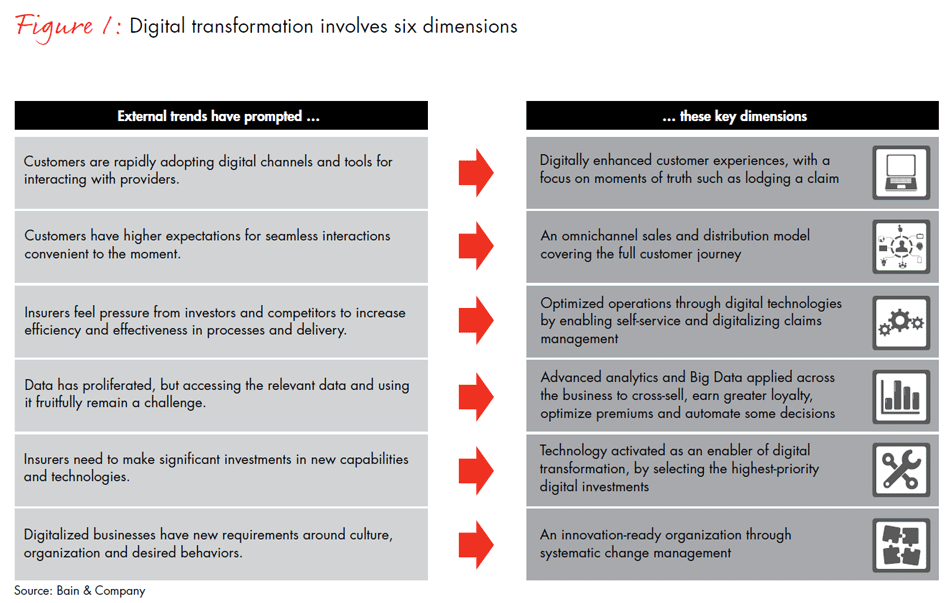
In each geographic region, the degree of digitalization varies widely among insurers, with no company achieving best in class across all six dimensions. Instead, certain companies lead in one or two. One insurer, for instance, has digitalized more than 80% of its processes and underwriting; another tracks more than 15 criteria to hone its customer segmentation. All insurers, though, will quickly have to meet a minimum threshold in each dimension to survive.
The benchmarking reveals patterns of responses that, when combined with qualitative analysis of current strategies, allow us to identify four major pathways leading insurers have taken to realize digital progress (see Figure 2).
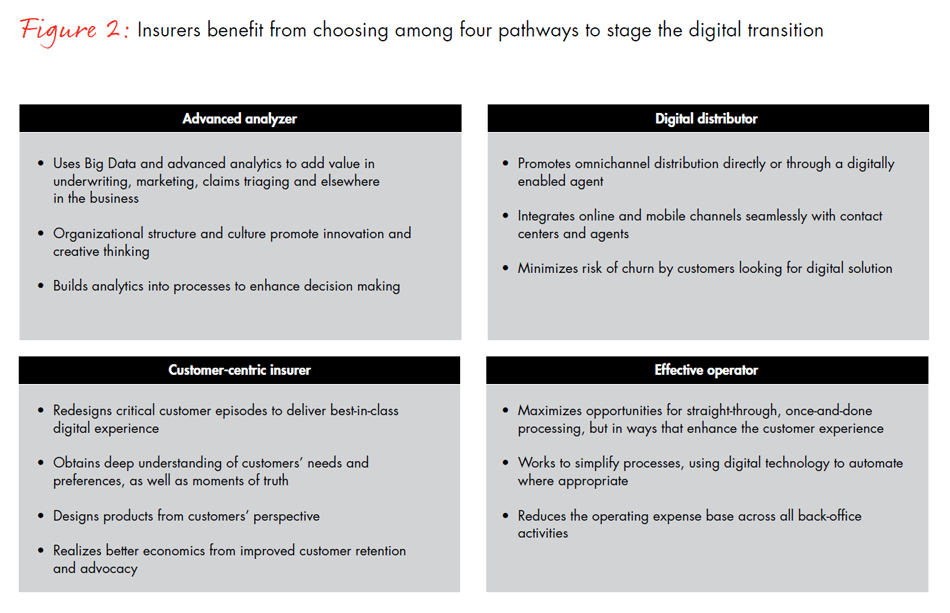
These pathways help orient companies on their digital journey, and they define the competitive advantage that companies can obtain, informed by their point of departure, their existing pre-digital business models and their core strengths:
- Advanced analyzer, at 31% of the total, is the pathway the largest group of respondents took, which is not surprising given the importance of analytics to the industry as a whole and the hunger to exploit Big Data.
- Digital distributor represents the pathway 20% of the respondent companies chose.
- Customer-centric insurer describes the pathway taken by 6% of the companies.
- Effective operator describes the pathway 11% of the companies took.
- In addition, 21% of the companies have no clear path and the lowest average digitalization level, putting them at a disadvantage in making the digital transition.
Let’s look at each of these pathways in turn.
The advanced analyzer
Many insurers have strong analytical capabilities in their actuarial group, focusing on how loss prediction can improve pricing or better detect fraud. But the potential for analytics is much broader, and the methods go beyond classic actuarial analysis. For instance, some high-performing firms deploy advanced customer analytics for risk selection, customer loyalty and claims management.
Much of the data in the future will be unstructured and found outside the policy administration system, so the model will require the capability to capture data at points of interaction with customers. It also requires an organization that is skilled at promoting innovation to apply Big Data, and eager to do so.
One analytics leader, Progressive in the US, has benefited from being out front with in-vehicle telematics and from running thousands of tests a year to systematically vary messages, product design and delivery channels. Other leaders include the Climate Corporation, which has upended the US crop insurance market, reducing farmers’ financial risks by crossing agriculture with Big Data analytics. Climate Corporation collects information on weather patterns, climate trends and soil characteristics, then crunches the data down to a farmer’s field. Using these insights, it offers policies against damage from weather events and uses the data for fully automated claims handling.
The digital distributor
More and more customers expect easy, convenient interactions with their insurance providers through any channel, so building an integrated offering has become an important element of earning customers’ advocacy. Omnichannel distribution, either direct-to-consumer or through agents with access to mobile applications and other digital tools, thus depends on seamless integration with physical operations like contact centers.
Only 8% of new life premiums and 10% of new P&C premiums flow through online or mobile sales channels today, though many insurers plan to increase that portion substantially. Companies pursuing a digital distributor model aim to accelerate the shift, with product features and pricing tailored for digital channels as needed. Service levels for digital-only distribution can be comparable to or even better than physical channels, because the company can start with a clean sheet and design simpler processes.
Direct digital distribution works best in regions like the Nordic countries, where consumers already show a strong digital uptake for other services, such as online banking. The primary challenge involves the inherent conflict between an insurer’s digital channels and its tied agent or broker organization.
Where the agent network is strong, some insurers have created a separate entity or brand with different pricing, to avoid or mitigate the conflict. Kyobo Life followed that logic when it created Kyobo Lifeplanet through a joint venture with Japan’s Lifenet; Lifeplanet offers a no-frills product line through its website. Over time, however, most companies will benefit from a Digical model with the same products and prices in all channels, which customers can access whenever convenient.
The customer-centric insurer
Insurers that double down on a customer-centric model mobilize their operations around the goal of earning greater loyalty and advocacy among customers. That’s because customers who are loyal promoters of their insurers stay longer, buy more, recommend the company to friends and colleagues and usually cost less to serve—with the mix of these forces dependent on the particular market and type of insurance. In the US, for instance, Bain analysis shows that a promoter’s lifetime value is worth nearly seven times that of a customer who is a detractor of the carrier.
Truly customer-centric companies regularly gather feedback from customers to identify patterns and take actions that will improve the customer experience. They put customers’ priorities front and center when designing products and services. Adding digital channels also allows insurers to interact more frequently with customers, and Bain’s customer surveys have found that more interactions can play a role in earning greater loyalty.
That’s a departure from most insurers’ internally focused stance, which assumes agents are the customers. In a business built around loyalty, the salesforce serves end customers, whether they are new or existing. Digital technology does not just support and automate internal processes; rather, it’s deployed to accommodate customers’ priorities in ways that can actually delight people. Incentives and processes also must align with the goal of providing customers with a superior experience. An insurer could measure its contact center, for example, on “first time right” call resolution rather than on average handle time.
Consider how Discovery, a major insurer based in South Africa, has generated exceptional growth over the past decade, in part through its customer-centric Vitality program, which appeals to people committed to healthy living. Vitality members accrue points for demonstrating certain healthy, safe behaviors, which are reinforced through discounts on gym memberships and healthy foods, as well as by installing tracking devices in cars. Members can redeem these points for rewards from other vendors. The digital component allows Discovery to more actively engage with customers. Vitality has built a healthier book of business with better risk profile and lower cost to serve, and the program has helped Discovery maintain a very loyal customer base. The customer-centric model brings several challenges. Companies have to decide which customer segments to target and put the needs of those customers first by addressing several questions: Which touchpoints and episodes will be most effective at earning loyalty? How can we build out digital channels for transactions and communications in a way that will improve the customer experience? What will the ideal experience look like 5 or 10 years in the future, and what does that mean for how the business needs to evolve today?
The effective operator
Huge opportunities to reduce costs and error rates abound in insurance. Among the benchmark participants, for instance, only 8% to 49% currently employ straight-through processing (STP), depending on the operation, and most experience error rates as high as 70% to 90% for certain paper forms.
The effective operator model seeks to create value by reducing operating expenses across all back-office activities, without compromising the customer experience. Digital technologies can even enhance the experience by making things like documentation much simpler. Relevant metrics include a low cycle time for claims, a high proportion of auto-underwritten and auto-adjudicated business, and straight-through, once-and-done processing wherever possible.
Auto-underwriting a health policy, for instance, allows customers to enter personal health data that a digital engine uses to calculate a base payment plus surcharge, producing a quote directly. Humans still need to read and approve the quote, but digital technologies accelerate the process and improve accuracy.
Established insurance companies have hundreds or even thousands of existing IT systems and applications to manage, and coordinating them to simplify processes constitutes a major management challenge. Also, the shift from manual to STP requires more IT experts and fewer administrative staff, mostly likely requiring a change in the mix of talent to successfully navigate the journey to operational excellence.
Harshveer Singh, a partner in Bain's Financial Services practice, presents key questions for executives to consider before they embark on their Digical journey.
A guide for organizing and investing resources
None of these pathways is inherently better than others, and they are not mutually exclusive. Customer preferences will compel insurers to raise their game over time on all digital dimensions. But by emphasizing one pathway, a company can focus scarce resources on the battles it must win today—and has a better chance of winning—than on trying to do everything at once.
Multinational insurers may want to pursue different pathways in different countries. In Germany, the price-sensitive auto insurance market favors highly effective operators, whereas relatively strict consumer privacy laws make the advanced analytics model less appealing. In Brazil’s fragmented insurance market, by contrast, advanced analytics can yield a high return when applied to customer segmentation, pricing and fraud prevention. Some emerging markets such as Indonesia are leapfrogging from paper processes directly to mobile technologies, so a mobile distribution play could make sense there. In the UK and Australia, any company lacking decent digital distribution will have a tough time surviving.
Established insurers have well-known brands, extensive tied agent and broker networks, and legacy systems and processes. But the complexity of the digital journey requires a clear roadmap to determine how to sequence the initiatives and how to organize for them. As insurers travel along one of these four pathways, they will have to integrate their physical assets with new digital assets and build a model for future growth, even as they manage the current business for next quarter’s results.
The hard work involves managing trade-offs, building the right governance and culture for innovation, developing new capabilities and engaging all of the stakeholders. Yet insurers have no option but to make the digital shift quickly, as today’s innovation quickly becomes tomorrow’s standard practice.
The chapters that follow detail how the benchmark panel of insurers performs along each dimension.
1. Global digital trends
- Executives from 70 insurance companies worldwide answered detailed questions about all aspects of their companies’ digital profile. The degree of digitalization varies widely among both life and P&C insurers in ever y region. Even the leaders, however, are far from being truly digital companies. On average, P&C carriers have a digitalization index score of just 48 out of a possible 100 and life carriers have a score of 45.
- The P&C sector has a slightly more developed digital profile, because P&C products have become more commoditized and distribution has been easier to shift online. Many products in the life sector, particularly investment-related products, still depend heavily on an agent or broker for advice. A truly digital business, though, goes well beyond distribution to include all activities, such as claims, underwriting, customer service and fraud protection.
- We broke down the digital profile into six categories, described in the introduction, and respondents assessed their companies’ position in each category on a scale from one to five. No single insurer excels in all categories, though many insurers now focus on building their capabilities in a couple of areas over the next several years.
- Consumers are setting the pace in the digital arena, as they expect to use the channel that is convenient for them at any given moment. Bain’s recent survey of more than 158,000 consumers in 18 countries found that the share of digitally active customers ranges from 35% to 70%, and over the next few years, 79% said they will use a digital channel for insurance interactions.
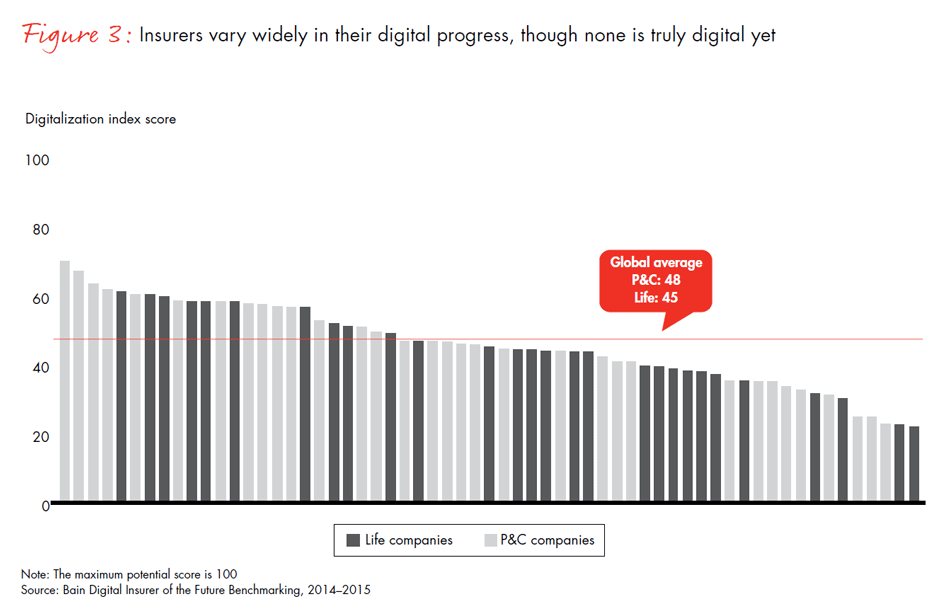
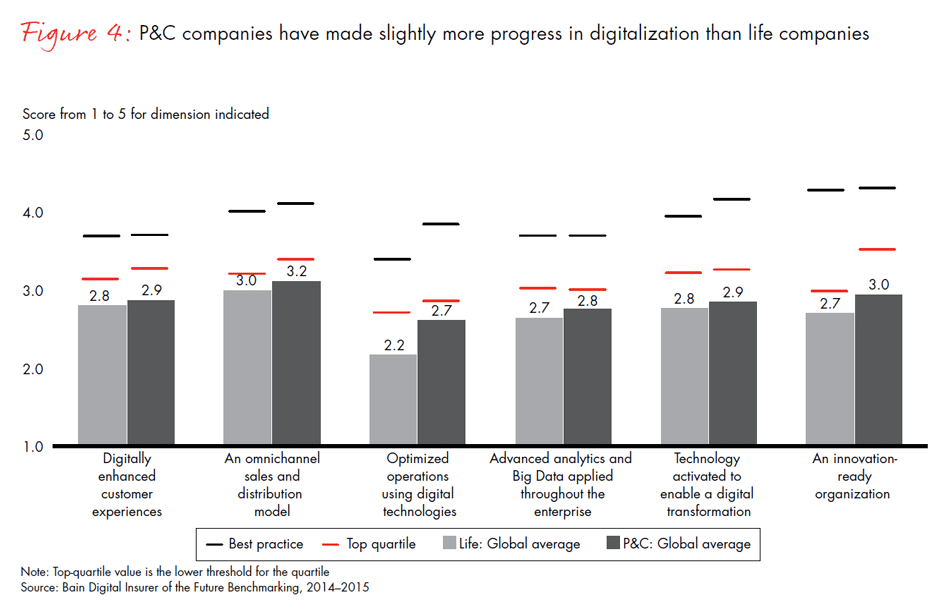
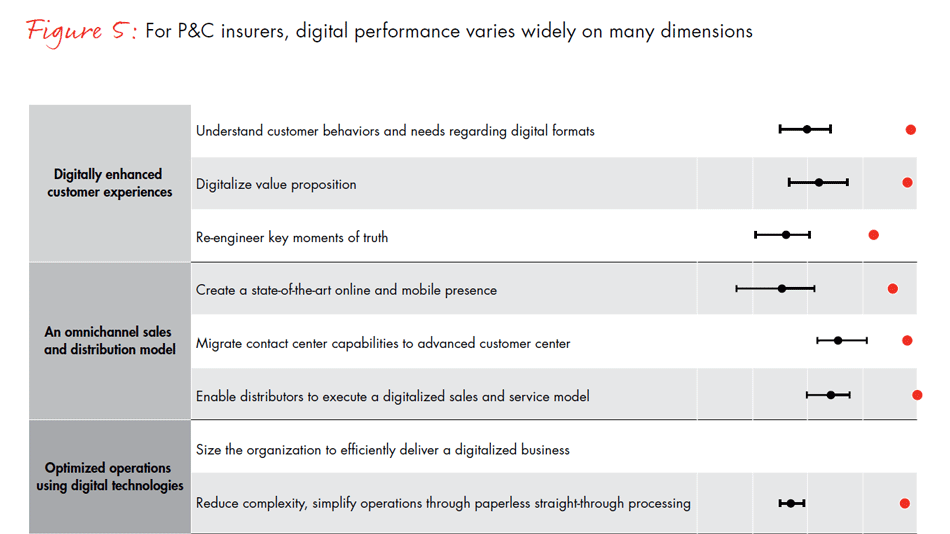
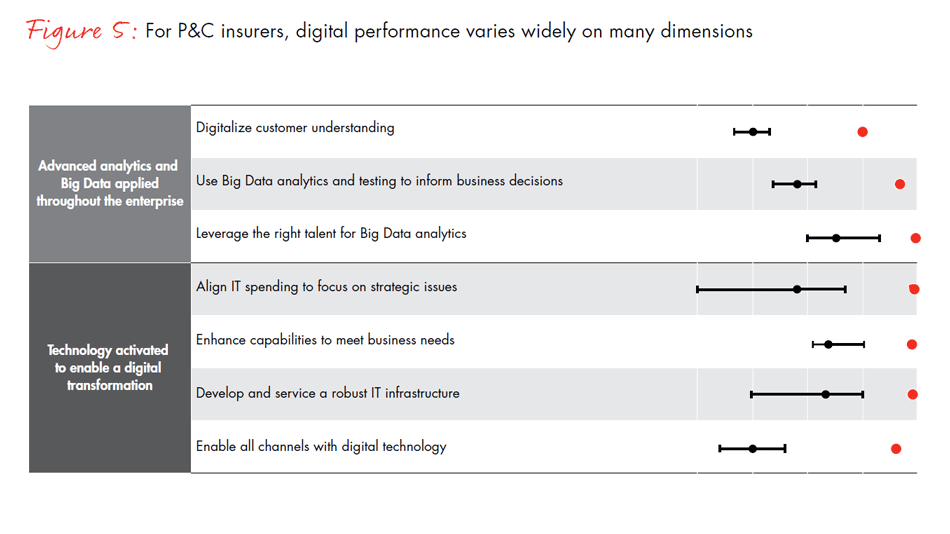
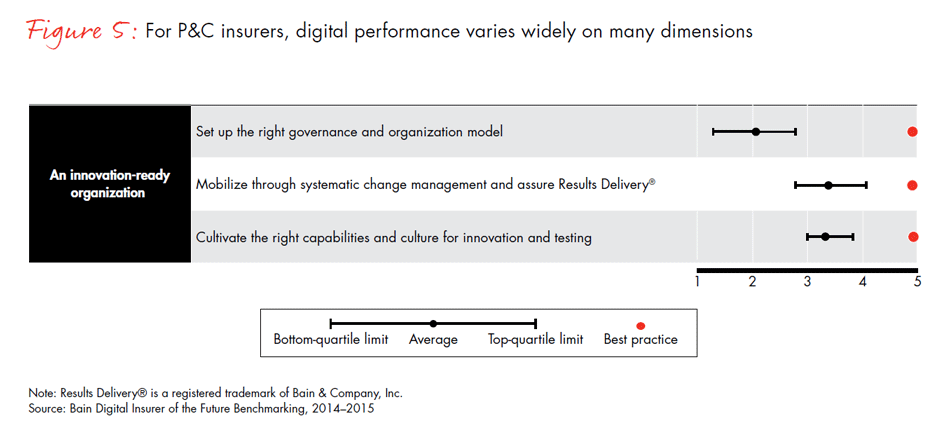

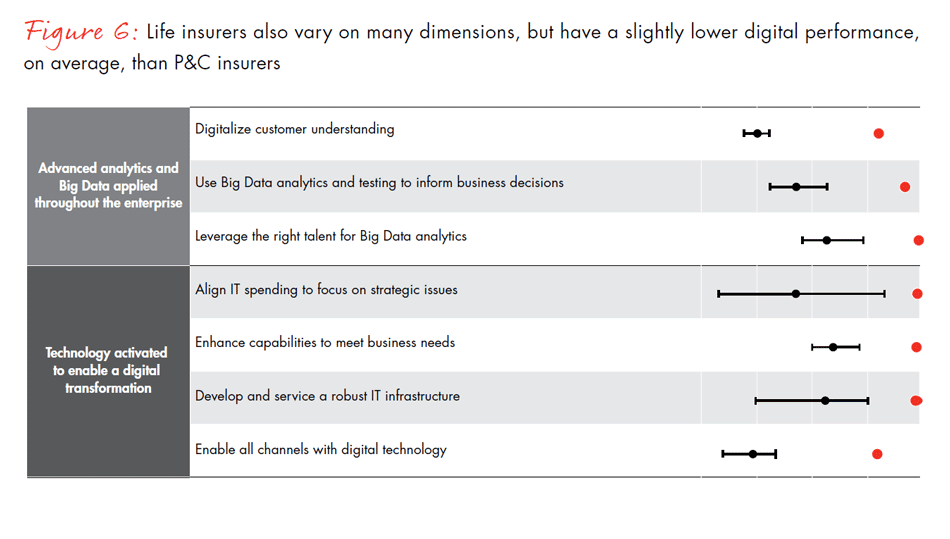
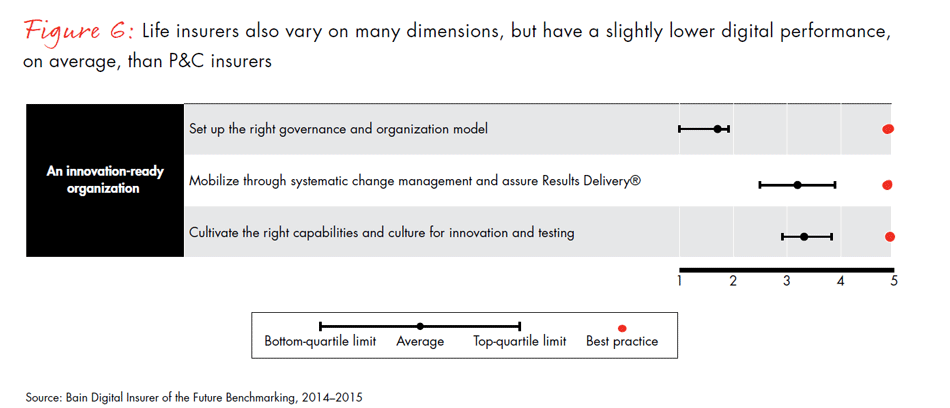
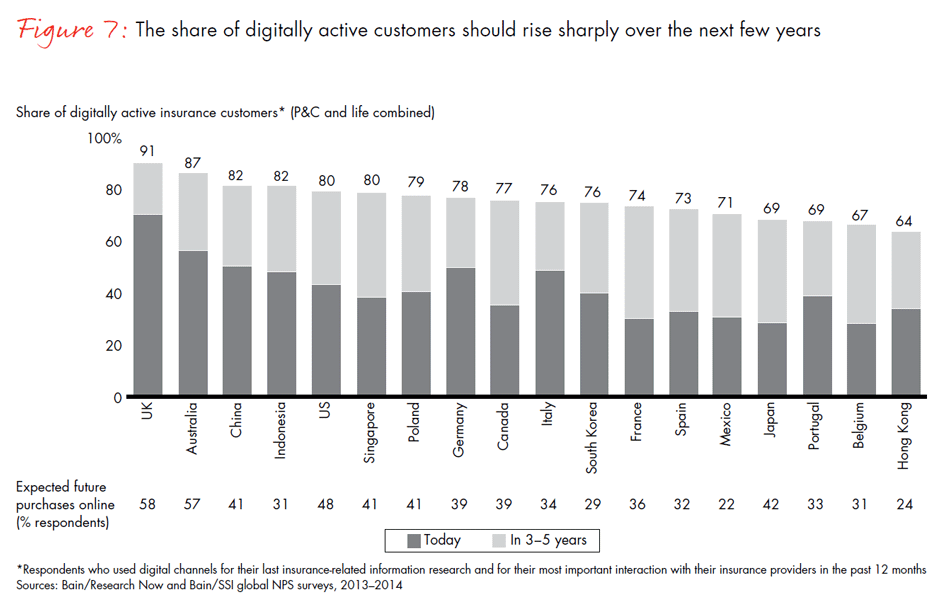
2. Digitally enhanced customer experiences
- For the majority of insurance companies, fewer than 11% of customers interact with them solely through digital channels. Yet both customers and insurers expect to see a major shift toward online and mobile channels and away from traditional channels, such as contact centers and in-person meetings with agents, in the next few years. The shift will be more pronounced in the Americas than in the Asia-Pacific region or in Europe. Therefore, insurers will need to prepare their traditional channels for the change.
- About half of insurers have specific offerings designed for their digital channels. The most common products tailored for digital include auto, home and contents, travel, medical and term life insurance.
- Most insurers make active contact with customers infrequently—every six months or longer.
- More than half of insurers expect to shorten the development time of new products by three to nine months over the next few years. Insurers expect development time to go from 11 months to 7.4 months, on average.
- Roughly half of insurers study customer needs and behaviors quarterly or more frequently, mainly using historical internal data and external market research. When it comes to customer segmentation, insurers’ methods still skew to traditional criteria, such as age, income and stage of life. Fewer insurers use behavioral, lifestyle or decision-style criteria.
- More P&C insurers than life insurers now measure the relative profitability at a product level for customers acquired through digital channels. P&C carriers find mixed results on the relative profit - ability of such customers.
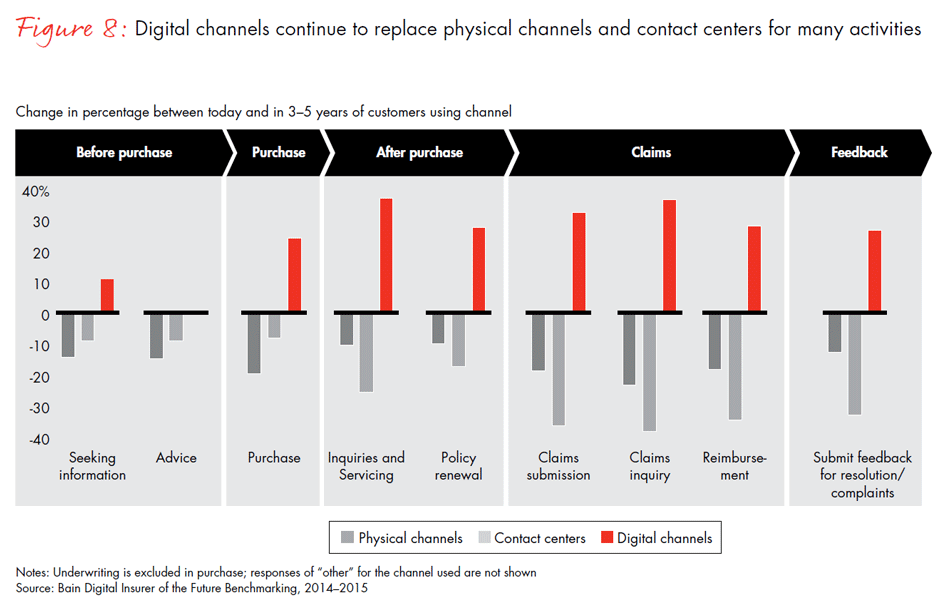
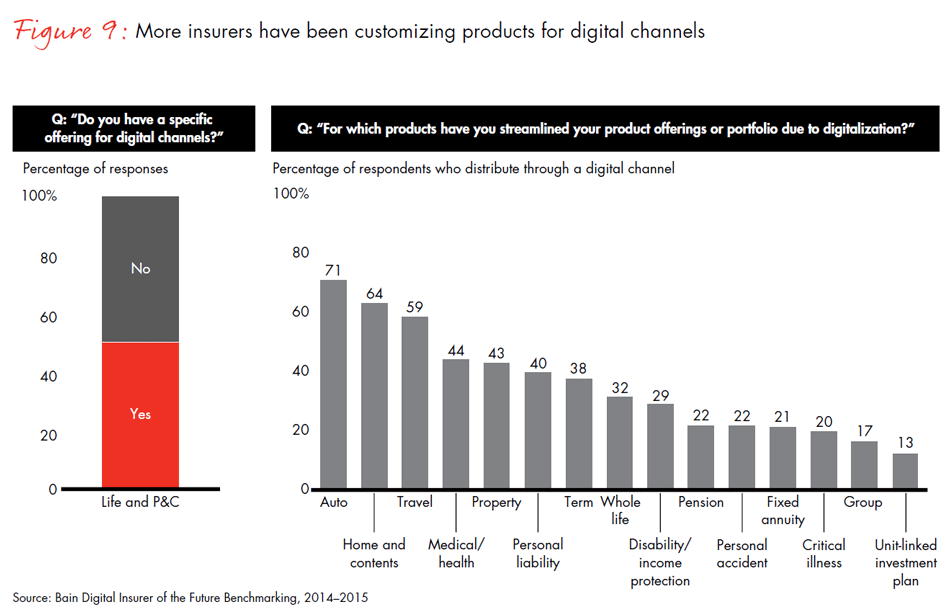
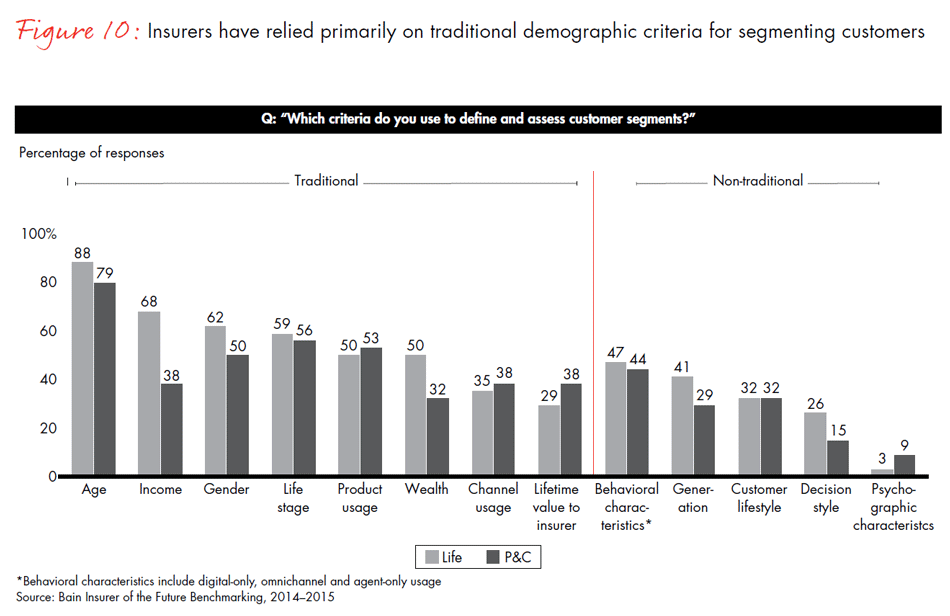
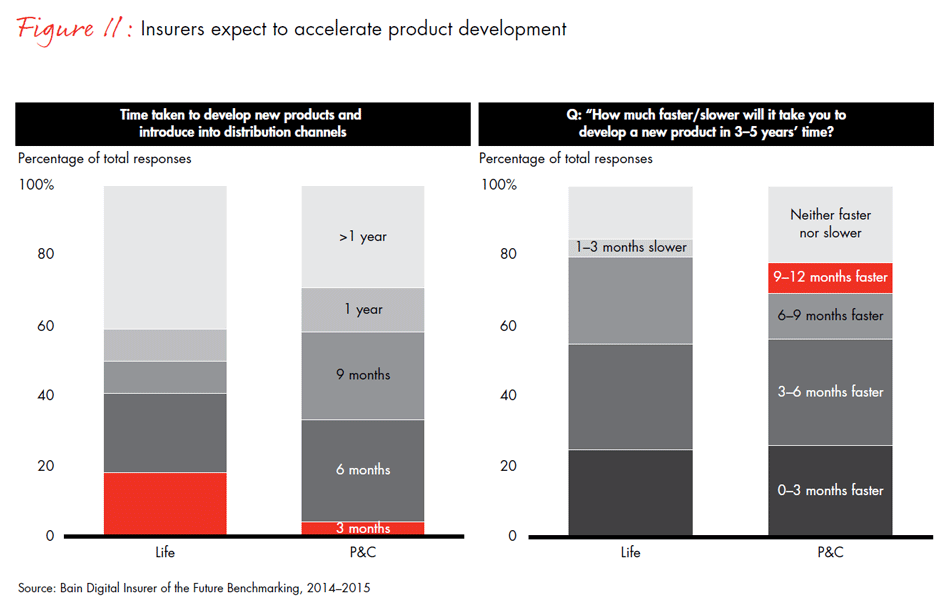
3. Digitally enabled sales and distribution
- Currently, insurers sell the vast majority of premiums through physical channels, whether through agents, brokers or banks. However, insurers expect new premiums generated from digital channels to more than double in the next three to five years: In life, from a weighted average of 6.2% to 14.9%, and in P&C, from 9 .7% to 22.5%. There’s a wide variation in the share of projected digital business among insurers.
- Very few insurers have complete omnichannel capabilities. In life, nearly one-third of carriers allow customers to start a transaction in one channel and complete it on another. In P&C, about 40% of carriers have that capability. Only one-third of all insurers contact customers if they abandon their application in any channel—and this lack of integration means insurers miss sales opportunities.
- More contact centers in life carriers than in P&C carriers can handle calls from agents and brokers. Many insurers are integrating their systems with those of physical distribution partners. P&C insurers have led the charge, with around 60% of surveyed insurers having achieved full integration, compared with around 40% of life insurers. The great majority believe digitally enhanced capabilities help their partners raise revenues, lower costs and deliver better customer service.
- Insurers expect to add multimedia capabilities to their contact centers, with an emphasis on co-browsing, mobile apps, chat/IM and video.
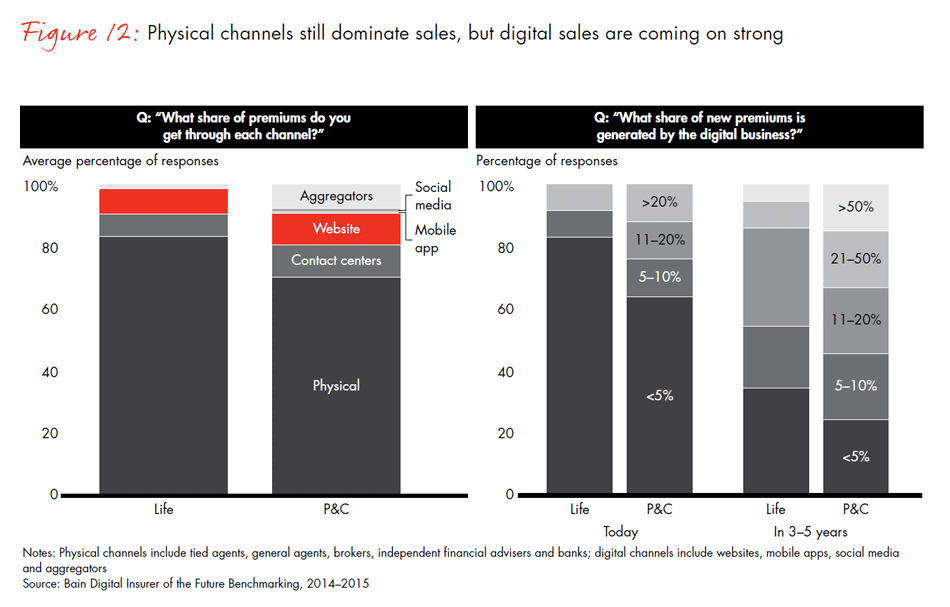
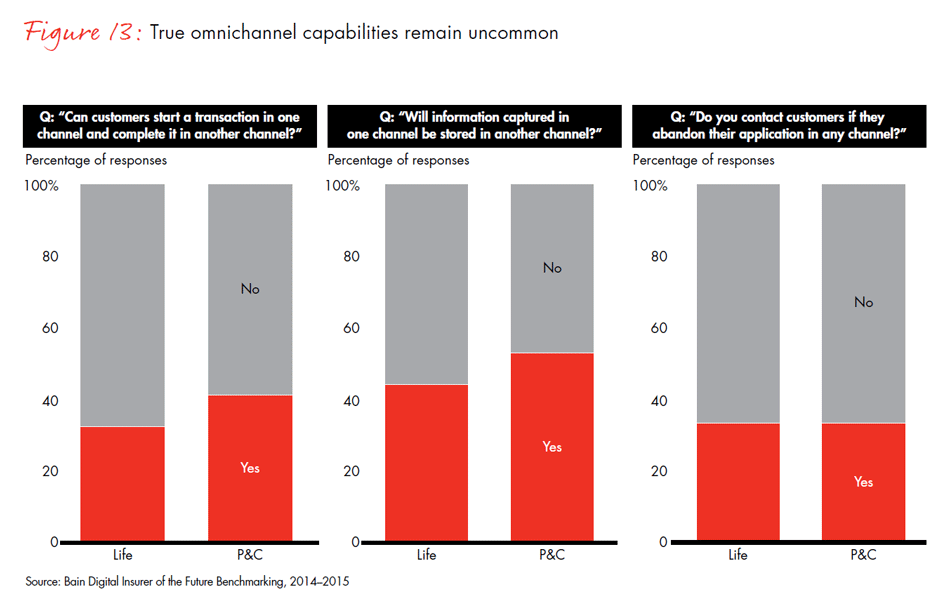
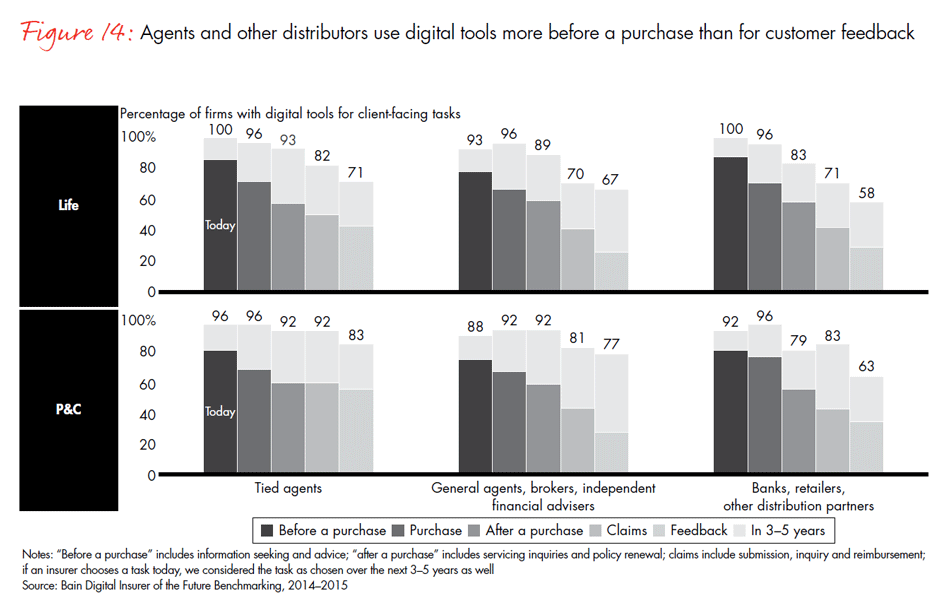
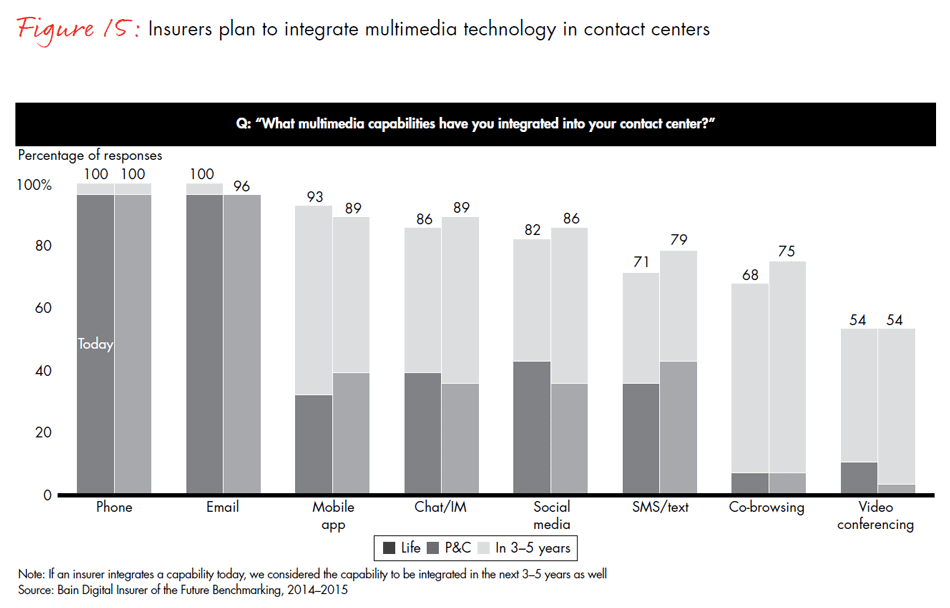
4. Optimizing operations through digitalization
- Insurers using digital technology to simplify their operations, products and processes report strong results from these initiatives, including a better customer experience and internal efficiencies through reduced error rates. The use of STP is rising across most activities, though insurers still use manual processing to capture most customer information. About 36% of P&C carriers now capture customer information electronically and process the data with STP.
- Between 41% and 65% of processing in P&C uses a once-and-done approach in which the customer does not need to be contacted after the initial interaction. In life, between 39% and 48% of customer interactions are once and done.
- Over the next three to five years, insurers expect a roughly 20 percentage point rise in the share of business that will be auto-underwritten and auto-adjudicated.
- Almost half of insurers have been able to reduce their headcount over the past three years, because they digitalized processes, mainly in policy servicing, application processing, sales and claims. They see further opportunities for efficiency gains, with staff reductions targeted for those same areas, plus underwriting and pricing in life. In P&C, about 15% of carriers even plan to reduce headcount by 20% to 40%.
- Cycle time for claims processing varies widely. Roughly 50% to 60% of carriers take more than seven days, depending on the product, with property, home and contents taking the longest time and travel taking the shortest time. One-fifth of insurers process claims in three days or less.
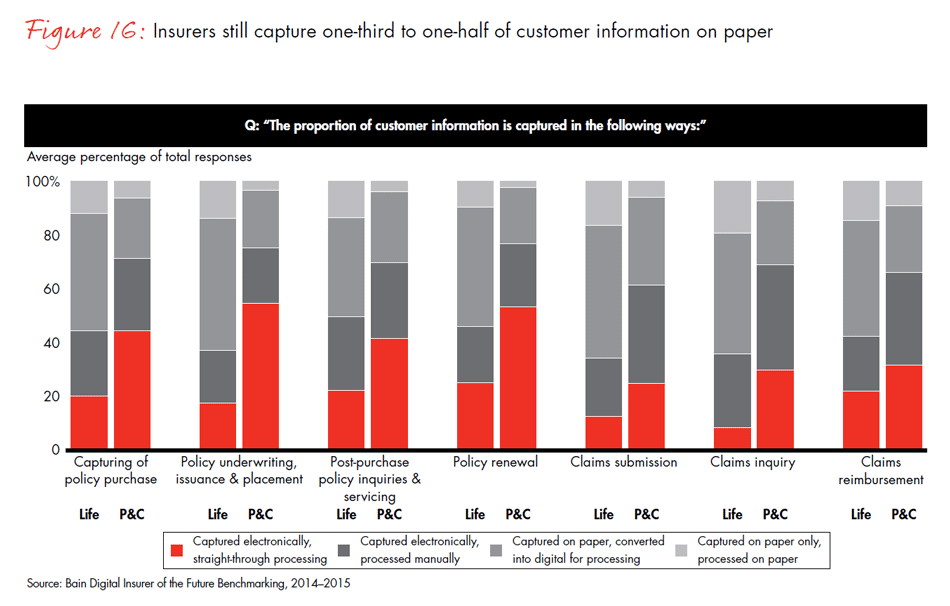
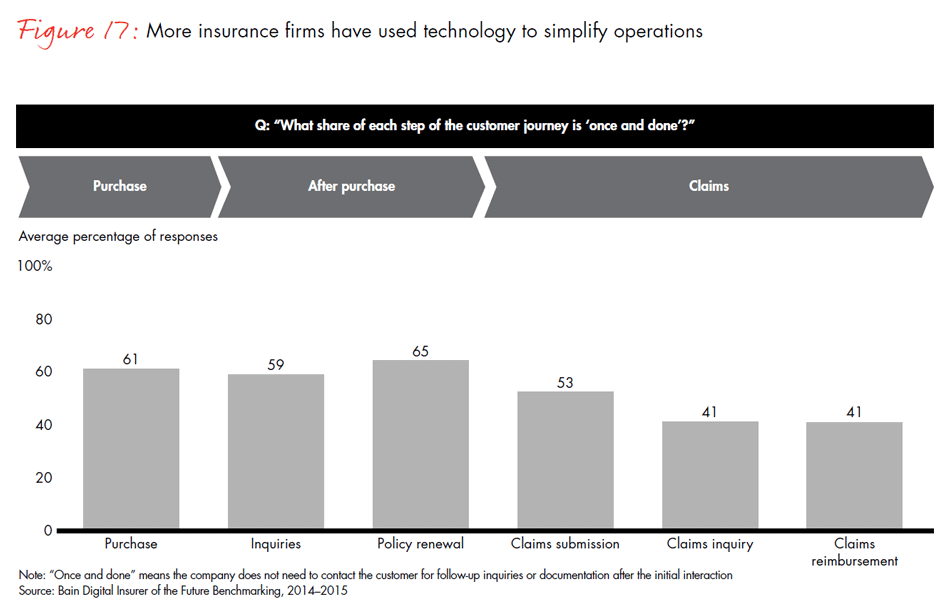
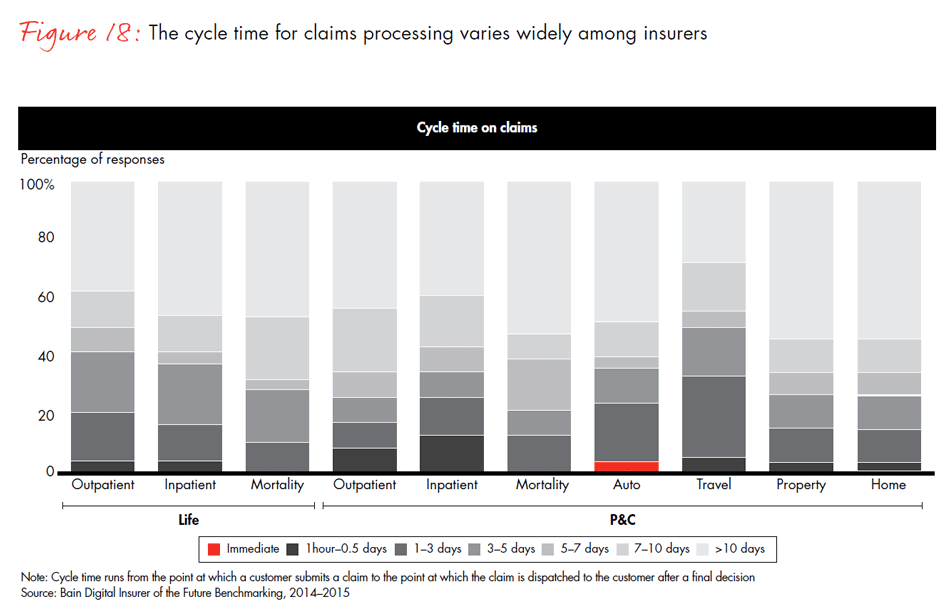
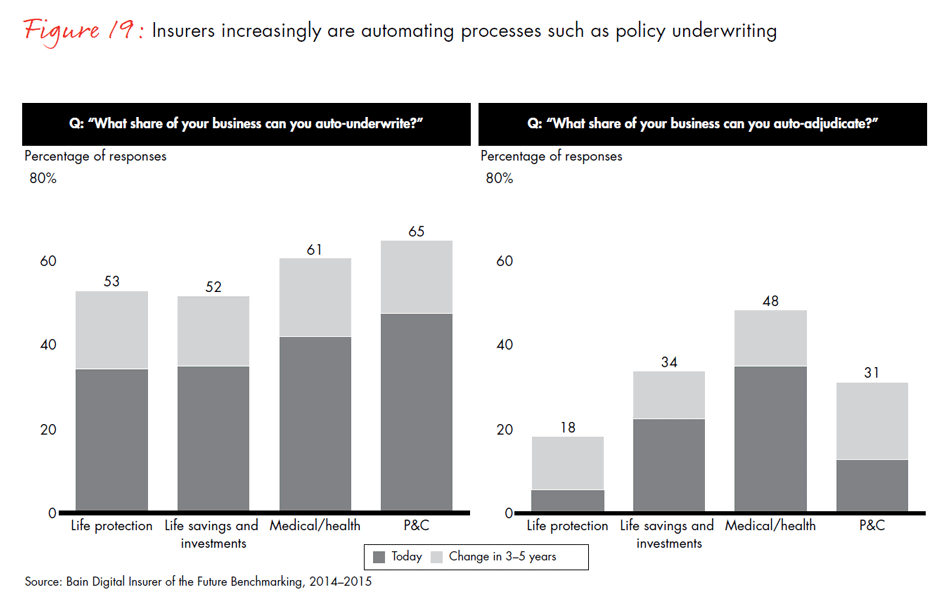
5. Advanced analytics and Big Data
- Most insurers recognize the benefits of Big Data analytics and test-and-learn methods, which hold great potential for understanding customer preferences, improving segmentation and assessing customer risk. New forms of external data, as well as digitalizing customer interactions, will prove useful in upselling and cross-selling products and in retaining customers. Insurers thus foresee that annualized spending growth on Big Data analytics over the next three to five years will reach 24% in life and 27% in P&C. Headcount will also grow, but at lower rates—13% for life and 10% for P&C.
- Today, however, the use of advanced analytics is still uncommon for certain activities. Fewer than 50% of P&C carriers and 35% of life carriers track any customer buying signals using digital technologies. Investment for retirement, buying a house and buying a car rank as the most commonly tracked signals.
- Even fewer insurers track changes in customer risk profiles. Potential fraud and driver safety rank as the most commonly tracked risk areas.
- Insurers plan to apply Big Data to an average of five functions over the next three to five years, up from two today. They expect the largest spending increase in Big Data analytics to flow to product design and pricing.
- As for test-and-learn techniques, insurers expect to increase their use by more than two times as they build and refine predictive models. They will use such techniques for about four functions, up from one or two today. Claims and product design and pricing will see the greatest rise in usage.
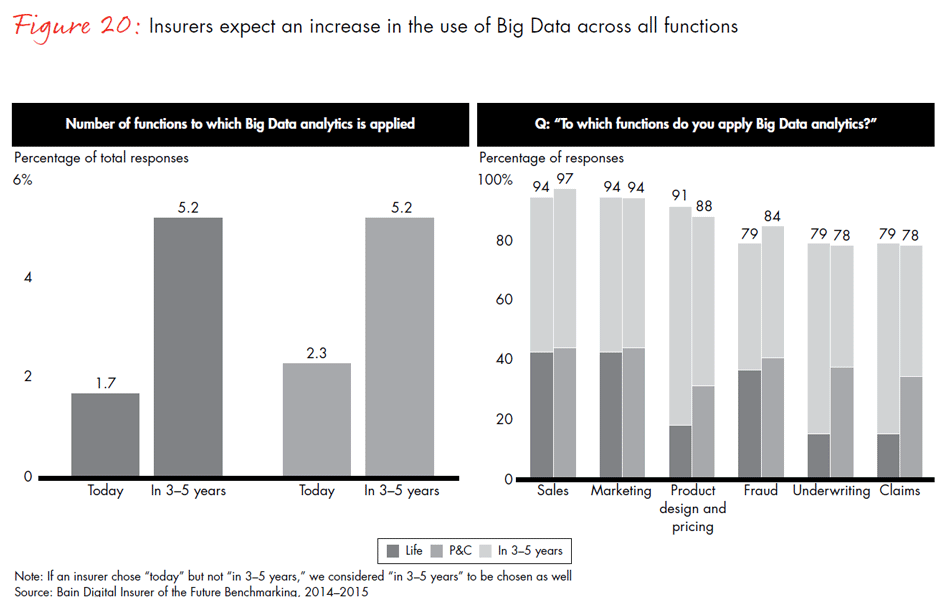
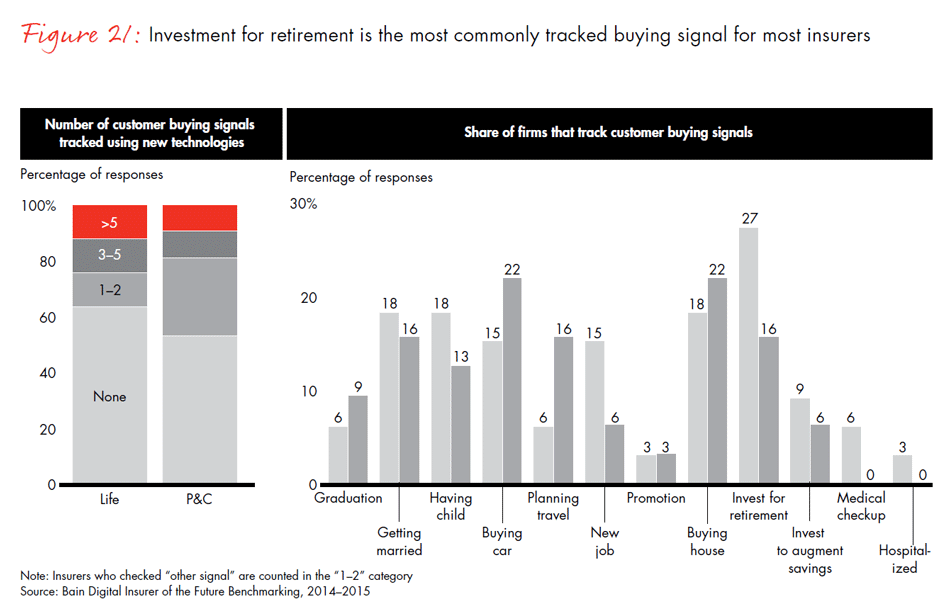
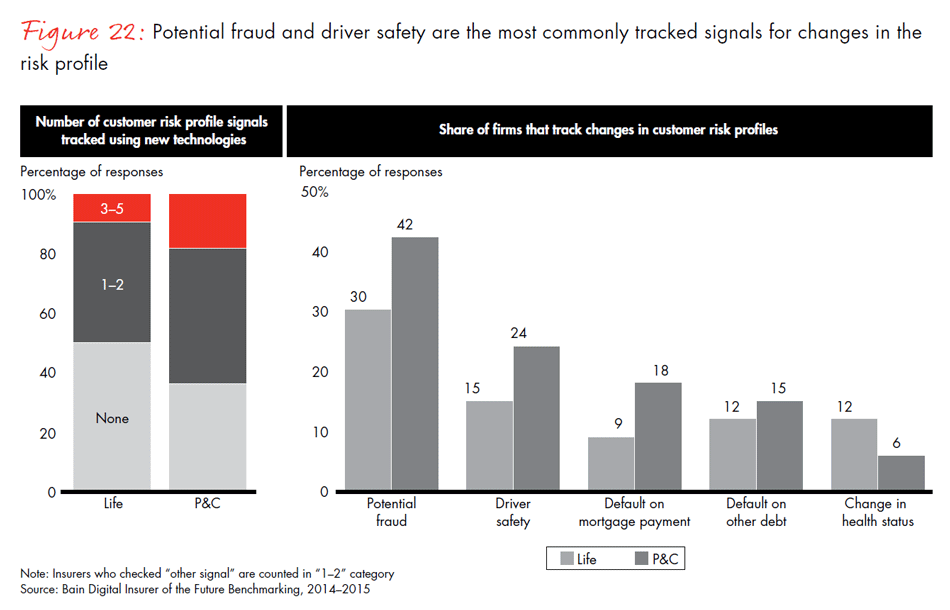
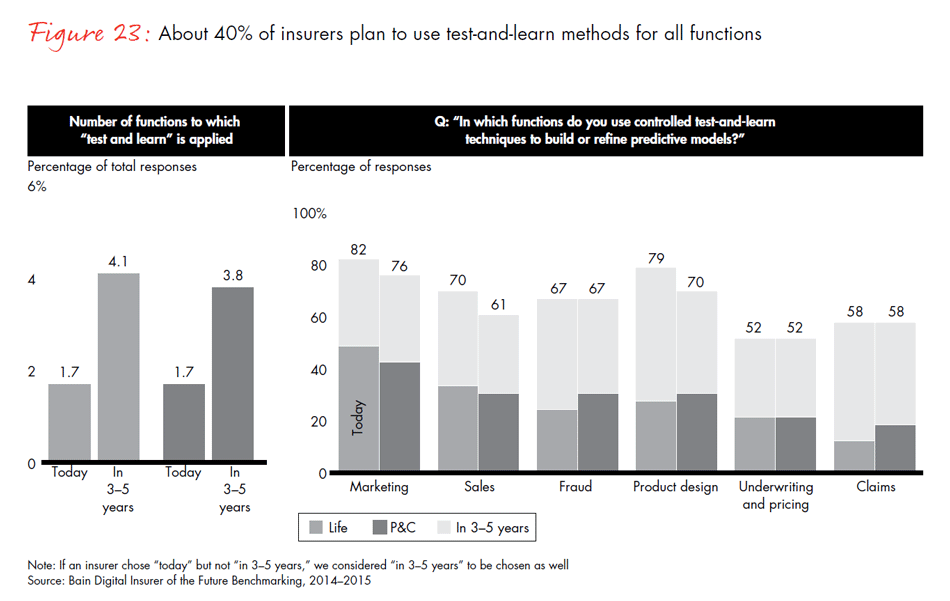
6. Digital technology as an enabler
- Insurers expect their IT spending to grow in relative importance over the next three to five years as many upgrade basic systems. Life insurers expect to increase IT spending from 3.8% of revenues today to 5.5%, and P&C insurers expect to raise IT spending from 3.7% of revenues to 4.1%. Spending responds in part to the need to build new capabilities, resulting in slightly higher systems development costs.
- The most common missing systems, which most insurers intend to invest in, include Big Data analytics, digitally enabled customer experiences and end-to-end customer relationship management (CRM) systems. Most companies also plan to invest in making data consistent across systems, the middleware spine and advanced security features.
- About two-thirds of carriers have a detailed roadmap to upgrade their systems architecture. Changing business requirements and outdated legacy systems lead the reasons behind systems replacement.
- Insurers have been investing in multimedia technologies, especially mobile, for their agents. About 60% of all insurers have equipped agents with mobile devices, and a smaller share has deployed tablets, web chat and high-definition video conferencing among the agent force.
- Many insurers believe equipping agents with multimedia technology has led to better customer service, higher revenues and lower costs. As customers increase their use of digital channels and expect seamless omnichannel service, the use of digital tools across all physical channels will be critical to connecting with customers. Many insurers, however, don’t measure the benefits of equipping agents or contact centers with multimedia technology.
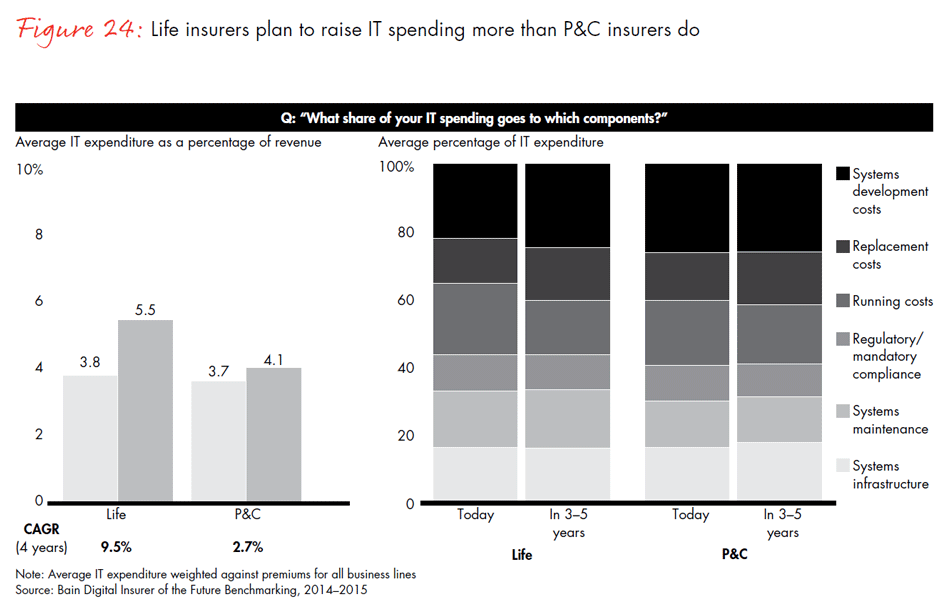
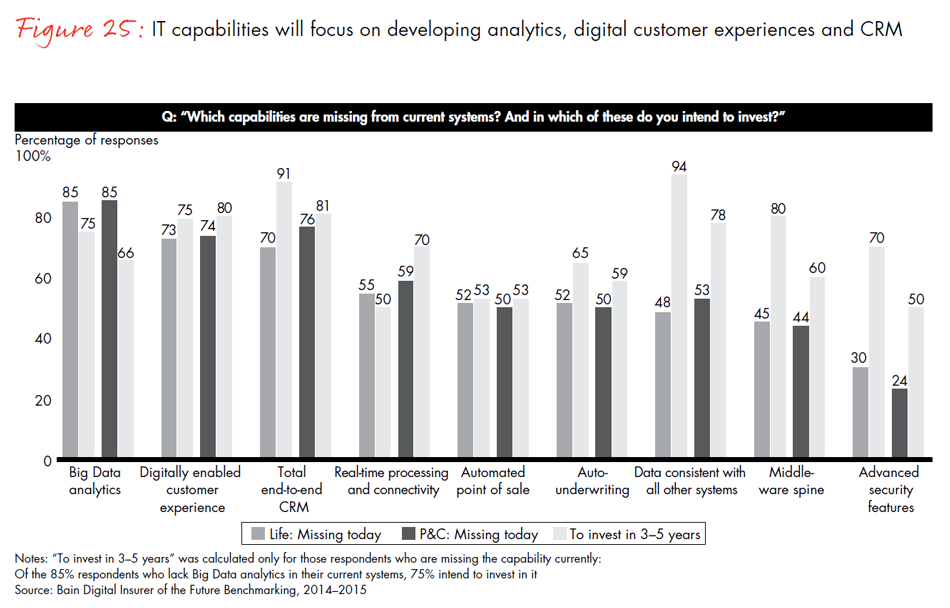
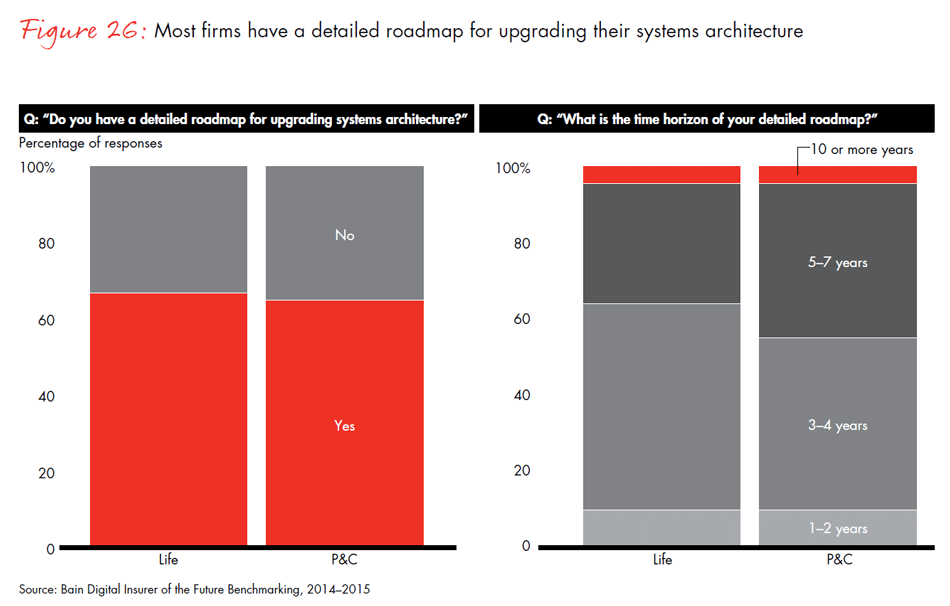
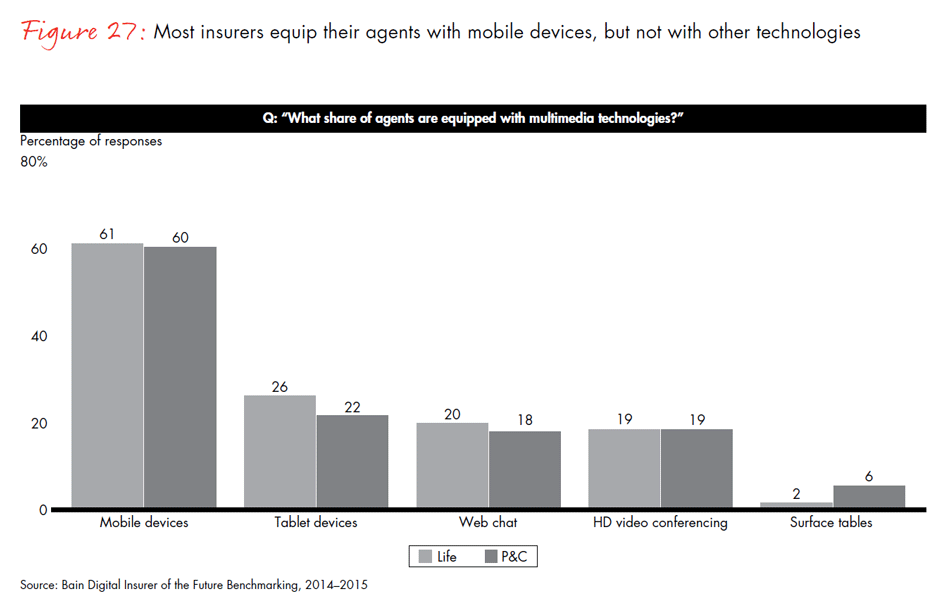
7. An innovation-ready organization
- Most insurers use digital tools and methods to evolve their current business models as well as to build entirely new digital businesses or standalone digital initiatives. They’ve had mixed success so far: About 41% of transformations among life carriers and 24% among P&C carriers have achieved fewer than half of the business objectives they set.
- Among the elements of change management, the areas of greatest concern are compliance and risk.
- A large majority of companies—approaching 80%—aim to run their digital business as a division within the existing company, using the same brand. About 40% of insurers have the CEO or the COO leading implementation of a digital transformation, and about 70% have undertaken the effort through the existing organization rather than creating a separate department. About half of insurers have dedicated innovation teams, though fewer have specific innovation centers.
- To promote a mindset and culture of innovation, almost two-thirds of insurers promote cross-functional teams. Yet to date, only half accept failures and only one-third give innovators sufficient time.
- To track progress, about half of insurers (more in P&C than in life) rigorously measure the success rate and results of their innovation. More than 70% engage in external partnerships in order to improve innovation. And about 65% scan the marketplace for competitor moves and disruptive models at least once a month.
- Consulting customers and other stakeholders about digital transformation remains limited. About 30% to 40% of insurers consult customers, agents or partners, and fewer than half even communicate about the topic to those groups.
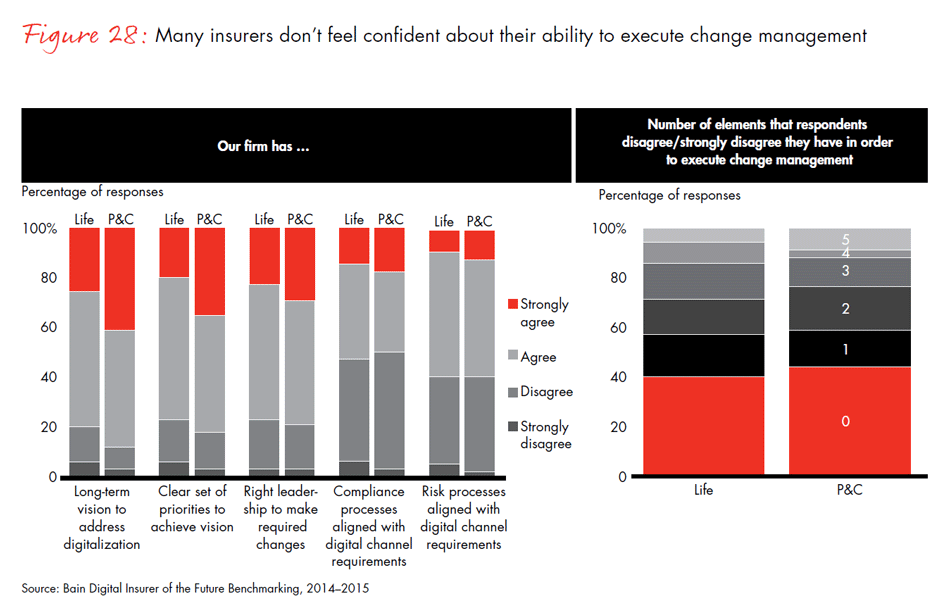
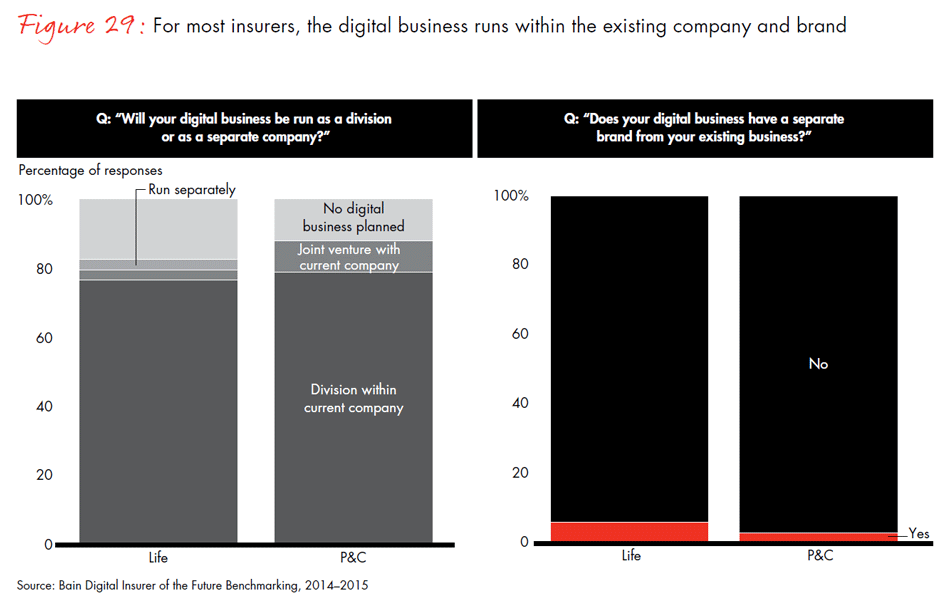
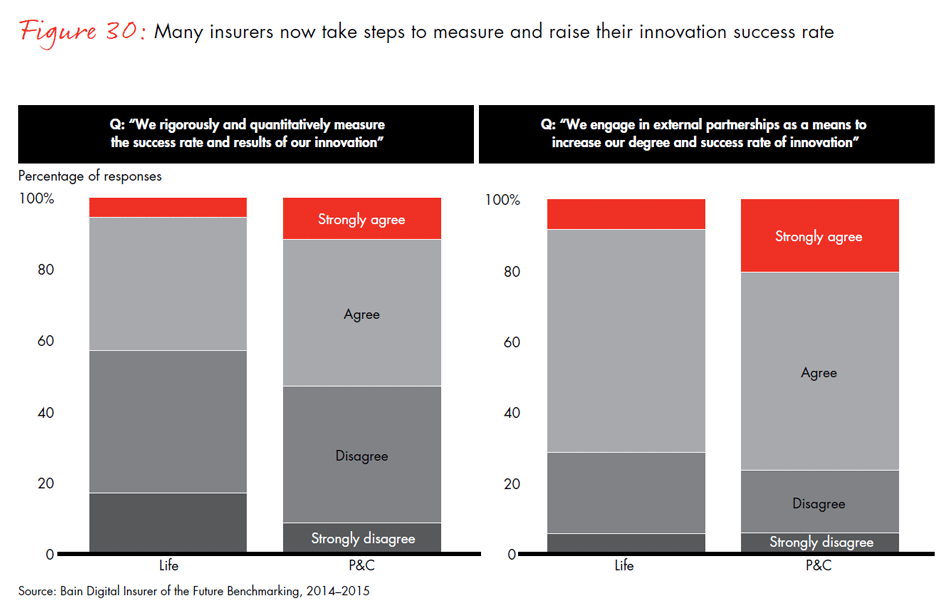
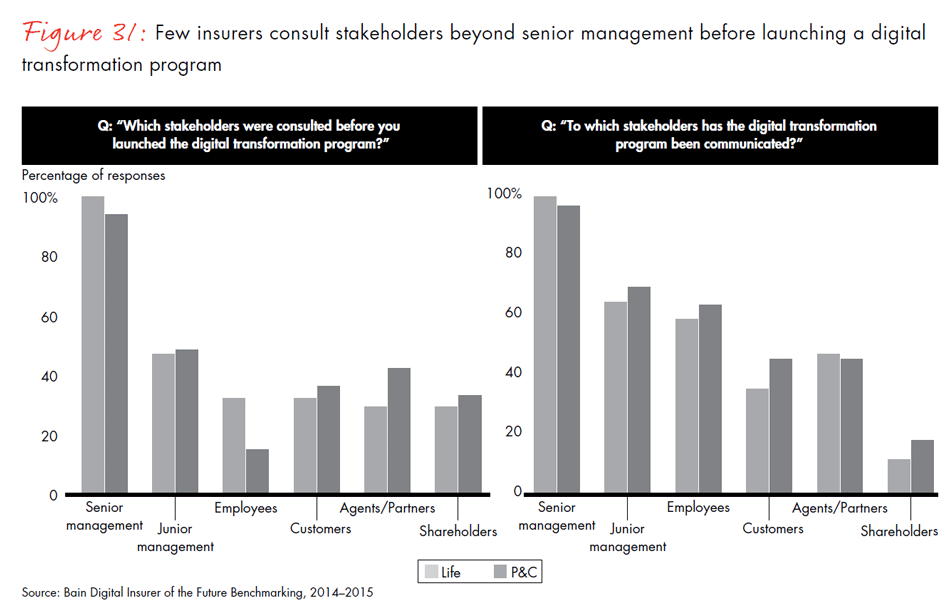
For information on the methodology used in this report, please see the PDF.


































